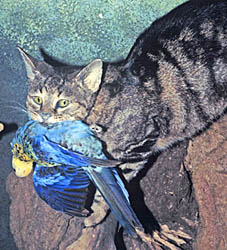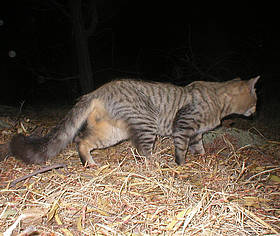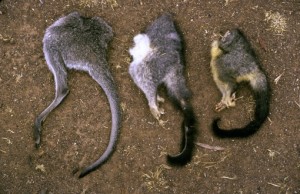Feral Felines: The Size of Dogs
Posted by: Loren Coleman on March 17th, 2011

Australian feral cats (above and below).

Ivan Sanderson and I use to talk about the reports heard in the 1960s of giant wild cats, domestic felids roaming in rural areas said to be huge. Now out of Australia, comes a contemporary account of such large felines.

Damage done by feral cats to Australian wildlife, including the brush-tail rabbit-rat. Photo: M. Evans.
A gang of feral cats “the size of dogs” has been terrorizing a neighborhood in the Australian city of Brisbane for more than a year, the City South News reported Thursday.
Residents in the suburb of Moorooka say they have been scratched, bitten, hissed at and intimidated several times by the feral felines.
Marlene Jans was taking her five-month-old fox terrier for a walk last Monday when two of the huge cats attacked.
“I was crossing the road, it was dark and I couldn’t see them,” Jans said. “Then, bam! One came at my dog, one came at me. One was biting my leg. I went for my dog because she was screaming.
“I had to kick them away. I was really scared and I was dripping blood.”
Her wound later became infected and she is now terrified to venture out at night.Source
About Loren Coleman
Loren Coleman is one of the world’s leading cryptozoologists, some say “the” leading living cryptozoologist. Certainly, he is acknowledged as the current living American researcher and writer who has most popularized cryptozoology in the late 20th and early 21st centuries.
Starting his fieldwork and investigations in 1960, after traveling and trekking extensively in pursuit of cryptozoological mysteries, Coleman began writing to share his experiences in 1969. An honorary member of Ivan T. Sanderson’s Society for the Investigation of the Unexplained in the 1970s, Coleman has been bestowed with similar honorary memberships of the North Idaho College Cryptozoology Club in 1983, and in subsequent years, that of the British Columbia Scientific Cryptozoology Club, CryptoSafari International, and other international organizations. He was also a Life Member and Benefactor of the International Society of Cryptozoology (now-defunct).
Loren Coleman’s daily blog, as a member of the Cryptomundo Team, served as an ongoing avenue of communication for the ever-growing body of cryptozoo news from 2005 through 2013. He returned as an infrequent contributor beginning Halloween week of 2015.
Coleman is the founder in 2003, and current director of the International Cryptozoology Museum in Portland, Maine.










Hmmmm. Interesting. The one with the budgie in his mouth, in the top pic, looks pretty scary.
For comparison, how large is a brush-tail rabbit-rat? (And which one of the above is the rabbit-rat hindquarters?)
Far left I’m assuming is some sort of wallaby?
What size dog are we talking about? I doubt the size of a lab or German Shepherd. I think they are talking about the size of a Lhaso Apso or even a Cocker Spaniel. That’s not so hard to believe.
Budgies are relatively small birds (I used to have a couple as pets) and I think an average sized cat would have no trouble with one. And many larger breeds of cats are regularly larger than small dogs. So none of this seems extraordinary at all.
Brush-tail rabbit-rat don’t seem that large upon searching, 150g or so, 1/3 lbs?
Guessing the two right ones in the picture are the rabbit-rat as the pictures I saw didn’t have the long hindlegs.
Perhaps these cats are variants of a Maine Coon? The males get quite large, up to 25lbs. About the size of a Jack Russell and other small terriers. The largest on record is 48 inches long and 35 lbs. There are breeders of Maine Coons in Australia, so not unlikely for a few to get loose and start breeding. The one carrying the bird does have the characteristic “M” on the forehead of Maine Coons, the second one has the fluffed tail as well, but neither seem to have the long hair of the breed.
I’ve got a cat that’s larger than a good many dogs — 18lbs and 3 feet long including tail. Maine Coons can grow to 25lbs and 40 inches long (including tail).
A 25 lb cat can be scary.
When I was a kid many years ago a domestic cat that was very large jumped on my sholder from a post. My thoughts are if they will attack a person with a dog then they need to be put down. To bad the National Govt. there took guns away from the people.
I suggest they buy a good adult air rifle and start to rid the place of the critters.
I’m looking at something that looks like the second picture! And he’s not even a Maine Coon, as far as we know. Someone on Catster was talking about her Maine Coon’s shoulder being above her knee, and a length of 49 inches head to rump. There’s nothing in these pictures to indicate size, except the parakeet, and they are not really big birds. I think they were hoping we would think the bird was a really big parrot or macaw.
You keep hearing stories from all over about feral cats, but no one has ever posted a verifiable photo with a size reference or measurements. Considering that most places treat feral cats like vermin–in Utah they just passed a bill allowing them to be shot on sight–someone must have killed one and taken a picture. Where are those trail cameras when we need them?!
jretzer i agree i too have a maine coon cat that i rescued from outside he is big 20lbs about 4ft long from tip of head to tail and very intelligent smartest cat that i know
According to the government here in Western Australia, the largest feral cat ever killed weighed 16kg (almost 36 lbs). That specimen was about 1m long excluding the tail. However, larger individuals have been reported including the cat shot be Kurt Engel which he estimated weighed about 30-35kg. However, from the pictures you can see that it was a little over 1m long excluding the tail, so putting it at around the same weight (16kg) as the largest feral recorded.
Given the planned breeding of domestic cats to wild cats to increase size (note the Savannah as one of the newer examples) it wouldn’t surprise me in the least that there would be hybrid offspring of some of the medium sized wild cats with the stray domestic. The ocelot on it’s own is about the size of a black lab, though not as heavy in the chest. It would also go some way to explaining why they aren’t afraid of humans as much as their wild brethren tend to be.
I worked in veterinary medicine for many years and we would often see large cats (especially maine coons) that would be pushing high 20 pounds. Most of the “large” cats were really “fat” cats though – extremely obese domestic house cats.
On the flip side of that is the feral cats – which were usually incredibly lean and would top out at maybe 10 pounds for a good healthy cat.
So the thought of a 25 to 30 lb. feral cat is quite disturbing.
As jretzer said above – this would be a very scary animal to run across – especially if it were hungry!
I also wonder (and not to jump on the “escaped exotic” bandwagon) if someone hasn’t been releasing Savannah cats into the Australian outback. These are a hybrid of a domestic house cat (bengal) and an African Cerval. The first generation crosses are reported to be 30-40 pounds, and since they are crossed with an African hunting cat would be superb hunters.
I suspect that Rebecca Lang at CFZ Australia is right- this is a beat-up. Here is the dog in question, and I suspect my cat (who is no giant) is hardly smaller. Moorooka is hardly outback Queensland, it is a suburb of Brisbane, and while I couldn’t say for certain this woman and her dog weren’t attacked (there are vicious cats just as there are vicious dogs) this is the kind of hysteria that could lead to mass culls or attacks on innocent animals. I recognise there are problems with feral cats around Australia and their effect on wildlife is a problem, but there are plenty of responsible cat owners as well. There must be humane ways of dealing with feral cats (and dogs) and this kind of reporting won’t help. Meanwhile, as Rebecca comments, *real* big cats are demonstrably now in the outback killing livestock and this just makes the idea easier to dismiss or scorn- as you can see in the comments at the article that Loren links to.
I have an orange Tabbi that is only 7-8 months old and he’s already the size of my Jack Russel, (adult and she’s about 20 lbs.) Although he’s half as heavy as she, he’s longer and just as tall. I suspect he’ll get much larger and heavier if he survives the neighborhood to full adult.
The biggest house cat I’ve ever seen was larger than an adult Bob Cat by about 3-4 inches at the shoulders but thinner. He ate several cans of tuna per day and lived indoors though.
On another note, if the Australian government hadn’t spent those hundreds of millions of dollars removing guns from the hands of her citizens, an entire community might not have to live in fear of a few house cats. Just my own thoughts here.
I really don’t understand what all the hoopla is about. In the 1970’s I shared my home with a bone white (normal eyes) 24lb 39 inch nose to tale alley cat. He was as gentle as could be with me and mean as a junkyard dog to everyone else.
No dog was safe around him. If a dog came in the yard he would attack. His first charge would generally knock over the canine, and made for a short fight. He came to his demise killing a pit bull that killed him six weeks later having done internal damage.
I took him camping often and he would hunt and kill rabbits or anything else he could scounge up and chase down. This was before the near universal threat of rabies in mammals inhabiting the high Sierra’s.
These cats really don’t look that big.
In reality, if they are, they may have interbred with larger cats in the area. This happened with feral pigs in the United States.
Cats can also have a ton of kittens fast, a cat can go into heat before 5 months of age, then just a few weeks later have seven kittens.
So a rare case of interbreeding may have actually caused some larger than normal cats. But they really don’t look that big at all. I don’t think I’ve ever seen a cat that couldn’t kill a parakeet.